|
Wednesday
12 September 2007
Today we do a walking tour of Glasgow with a private
guide. We are met by Lucie, director of Pure
Dead Brilliant Tours, who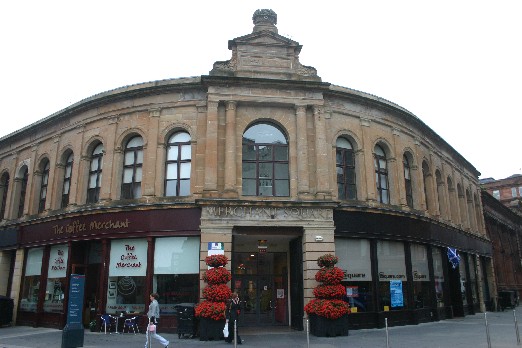 takes care of the money and introduces us to the guide, Michael. Michael arrives
promptly at 9.30 and guides according to a previously agreed itinerary. We start in Merchant City,
the 18th century business district, recently come to live again. We visit the
Ramshorn Churchyard with its gated graves. The gates had to stop thieves
stealing the bodies for the anatomy classes of the university. A bit further
down we walk through Candleriggs, a street with the former covered fruit market,
now an arcade with eateries and cafés. Glasgow Cross was once the centre of Glasgow,
until the train station was opened near George Square which sparked a shift of
the centre towards the west. We see the Tolbooth Steeple, a church tower without
a church from the 17th century. We follow the High Street towards the Cathedral,
still standing at the spot where once the Medieval settlement started. Little is
left reminding us of those medieval days. Only the cathedral and a former Inn.
That Inn, the Provand's
Lordship is now the oldest building in Glasgow. Construction of the
cathedral
was started in the early 13th century and was completed at the end of the 15th.
Thanks to the guilds the church escaped destruction by church reformers in the
16th century, a fate of so many churches in Scotland. The churches interior is
still in tact. The church is dedicated to St Mungo, allegedly the city's
founder. Symbols of his legendary life return in the city's coat of arms: a bird
(which he called back to life), a bell (he rung to call the people to prayer), a
tree (which he got to burn spontaneously) and a fish (he caught with the wedding
ring of a repenting adulterous queen in its mouth). Next to the cathedral is the
takes care of the money and introduces us to the guide, Michael. Michael arrives
promptly at 9.30 and guides according to a previously agreed itinerary. We start in Merchant City,
the 18th century business district, recently come to live again. We visit the
Ramshorn Churchyard with its gated graves. The gates had to stop thieves
stealing the bodies for the anatomy classes of the university. A bit further
down we walk through Candleriggs, a street with the former covered fruit market,
now an arcade with eateries and cafés. Glasgow Cross was once the centre of Glasgow,
until the train station was opened near George Square which sparked a shift of
the centre towards the west. We see the Tolbooth Steeple, a church tower without
a church from the 17th century. We follow the High Street towards the Cathedral,
still standing at the spot where once the Medieval settlement started. Little is
left reminding us of those medieval days. Only the cathedral and a former Inn.
That Inn, the Provand's
Lordship is now the oldest building in Glasgow. Construction of the
cathedral
was started in the early 13th century and was completed at the end of the 15th.
Thanks to the guilds the church escaped destruction by church reformers in the
16th century, a fate of so many churches in Scotland. The churches interior is
still in tact. The church is dedicated to St Mungo, allegedly the city's
founder. Symbols of his legendary life return in the city's coat of arms: a bird
(which he called back to life), a bell (he rung to call the people to prayer), a
tree (which he got to burn spontaneously) and a fish (he caught with the wedding
ring of a repenting adulterous queen in its mouth). Next to the cathedral is the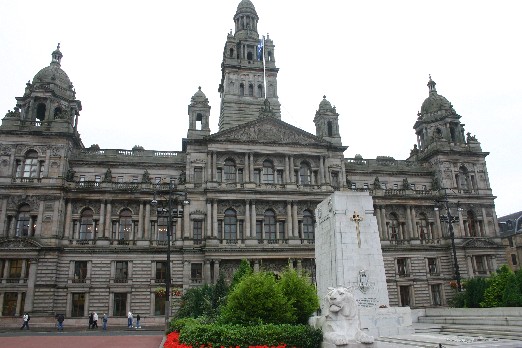 Necropolis,
the Père Lachaise of Glasgow. It is a hill with a extensive collection of grave
monuments for the well to do in 19th century Glasgow. Necropolis,
the Père Lachaise of Glasgow. It is a hill with a extensive collection of grave
monuments for the well to do in 19th century Glasgow.
We walk back towards the city centre around
George Square and Enoch Square. On George Square are the Victorian City
Chambers from 1888, where the city government and the city council have
their seat. On the square are statues of important Britons, but above all Scots,
like Sir Walter Scott, looking over the city from his column. Around him are
many others like Queen Victoria, James Watt and Robert Burns. Our guide spends
more time at the statue of John Moore, a general who fought
Napoleon in Spain and Portugal, because he is one of the few with a real Glasgow
connection. We then walk past the Gallery
of Modern Art in Queen Street. The façade is pure classicistic, but it
is actually a new front for what once was country manor for the tobacco trader William
Cunningham
from 1775 and which was situated a long way outside the city at the time. Once
the city caught up with the house it changed function a few times (stock
exchange, library) and it got its classicistic façade. When the building became
a museum its fronton was adorned with a modern mosaic representing the symbols
of St Mungo.
We now get to the beating shopping heart of Glasgow with
the big shopping streets like Argyle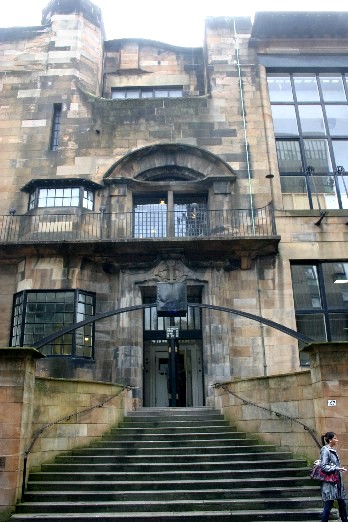 Street, Buchanan Street en St Enoch Square.
Princess Square, a tiny square lends its name to a large covered shopping mall,
in which original elements of the old buildings have been integrated. Michael
points a couple lovely alleyways and squares we would otherwise never have
noticed. Via
Mandela Place and West George Street we reach the former financial district of
the city. Here we find two buildings designed by the
architect Charles Rennie Mackintosh (1868-1928), who developed his very
own style in which he matched Art Nouveau, Art Deco, Classicism and Modernism.
He got quite a following and laid the foundations for the Glasgow Style in
architecture, design en applied art. In his own time he got little acclaim
outside his faithful circle of admirers, but after his death and certainly these
days Mackintosh style has gained a certain iconic status for the city. He is
often imitated (usually by shop designers) and you see a lot of Mockintosh
in the street. We have look at the half hidden building in Renfield Lane,
he designed for a newspaper (editorial rooms, management and print shop) and end
up at the Lighthouse,
Mackintosh first big commission. In 1895 it was home to the Glasgow Herald. In 1999
it was beautifully restored and converted into Scotland's Centre
for Architecture. It also has a special Mackintosh Interpretation Centre.
We have lunch in a restaurant at ground level in the Lighthouse. Street, Buchanan Street en St Enoch Square.
Princess Square, a tiny square lends its name to a large covered shopping mall,
in which original elements of the old buildings have been integrated. Michael
points a couple lovely alleyways and squares we would otherwise never have
noticed. Via
Mandela Place and West George Street we reach the former financial district of
the city. Here we find two buildings designed by the
architect Charles Rennie Mackintosh (1868-1928), who developed his very
own style in which he matched Art Nouveau, Art Deco, Classicism and Modernism.
He got quite a following and laid the foundations for the Glasgow Style in
architecture, design en applied art. In his own time he got little acclaim
outside his faithful circle of admirers, but after his death and certainly these
days Mackintosh style has gained a certain iconic status for the city. He is
often imitated (usually by shop designers) and you see a lot of Mockintosh
in the street. We have look at the half hidden building in Renfield Lane,
he designed for a newspaper (editorial rooms, management and print shop) and end
up at the Lighthouse,
Mackintosh first big commission. In 1895 it was home to the Glasgow Herald. In 1999
it was beautifully restored and converted into Scotland's Centre
for Architecture. It also has a special Mackintosh Interpretation Centre.
We have lunch in a restaurant at ground level in the Lighthouse.
Later in the afternoon we visit the Glasgow
School of Art, Mackintosh' masterpiece. We are guided around the
building by one of the students. The building is totally thought through and
consequent in style, although it has been built in two phases. His commission
was to create something artful, functional and economical and he succeed on all
counts, despite the frivolously oval windows. The GSoA is a top institute and
students are very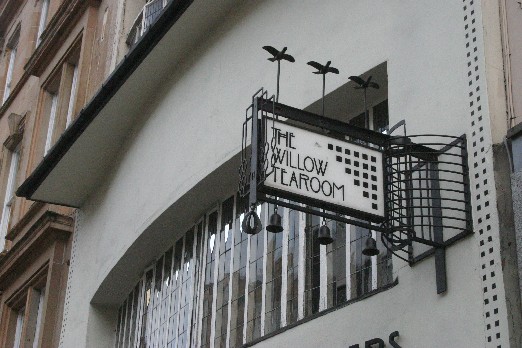 proud to be able to study here. It is a working academy and we are not allowed
to take pictures inside. Highlights are, without a doubt, the library,
accessible only for teaching staff and the exhibition of furniture designed by
Mackintosh and his contemporaries. Well known are Macktintosh's high dining
chairs with the ladder like back rest.
proud to be able to study here. It is a working academy and we are not allowed
to take pictures inside. Highlights are, without a doubt, the library,
accessible only for teaching staff and the exhibition of furniture designed by
Mackintosh and his contemporaries. Well known are Macktintosh's high dining
chairs with the ladder like back rest.
We walk back via Sauchiehall Street. A shopping street as
well, but a bit quieter. We go for a cup of tea at the Willow
Tea Rooms, This one of the tea rooms Mackintosh designed in Glasgow. The
Tea Room is located upstairs from a jeweler's shop and is gracefully designed in
Glasgow Style. What we see now is a meticulous reconstruction of the original of
1904, which Mackintosh designed for Kate Cranston, one of his few supporters
among his contemporaries. The Tea Room was reopened in 1980 after being closed
for 50 years. The name was derived from the street name, Sauchiehall, which
means Willow Lane in Gaelic.
At night we eat at Mao
bar and café (oriental) and watch football on TV (England-Russia and
France-Scotland), After that we go to Revolver Bar a traditional pub in a cellar
with a friendly crowd. Later during the night - when we are already in bed - we
hear lots of chears of happy football fans, who are loudly celebrating
Scotland's victory over France in Paris, earlier that evening.
Weer: dry, slightly overcast and some sunshine.19°C/66°F
Thursday 13 September 2007
Glasgow - Trossachs - Edinburgh
149km / 93mi
We leave town in a Northerly direction towards the Trossachs.
This is a national park around 50km (30mi) north of Glasgow. We first go
to Aberfoyle, where we have a coffee. The village calls itself
gateway to the Trossachs. Rightly so, because the NP starts right outside the
village. The road goes steeply upwards, up Duke's Pass op, taking us into Queen Elizabeth Forest. We
veer off the paved road and follow the Three Lochs Forest Drive. This is
a (one way) forest drive, leading through a beautiful part of the forest passing
three Lochs (lakes). It is like a long forest walk, only in a car. At the start
of the drive is a collection box, where you have to deposit two pounds towards
the upkeep of the drive. After half an hour or so the drive joins the main road
again. We continue until an turn off towards Lake Katrine. Here is the
starting point of the steamer Sir Walter
Scott. It turns out that the boat has already left 30 minutes ago by the
time we get there. It is a popular tour to take a rental bike with you on the
boat and sail to
Stronachlachar and ride the bike back to the starting point again. We continue
instead by car and drive directly to Edinburgh.
In Edinburgh we soon find Ardmor
House, our B&B for the next two nights. Colin and Robin give us a warm
welcome. We are off with the bus to the town centre  (day ticket £2,50, no change given) and have lunch on the top floor of the prestigious
London department store Harvey
Nichols, that has a branch here. It is a brand new building on St Andrew
Square. The doorman opens the door for us and the restaurant offers fine views
of the city and beyond. After lunch we take a bus 36 to the Scottish
Parliament. Since 1999 Scotland has, for the first time since 1707 when
the Act of Union was signed with England, its own parliament. Since 2004
parliament sits in a new building designed by the Catalan architect Enric Mirales. We
want to visit, but there is a full session going on, so there are no tours. We
can watch the debate. The debating chamber is very light and modern, with all
kinds of references to Scottish icons. After the visit to the parliament we go
back into the city centre and have a pint at the Café Royal Circle Bar.
A classical bar with an impressive Victorian decor. Especially the elliptical
shaped island bar and the tiled pictures of famous Scottish inventors are very
nice touches. The beer is good too, by the way.
(day ticket £2,50, no change given) and have lunch on the top floor of the prestigious
London department store Harvey
Nichols, that has a branch here. It is a brand new building on St Andrew
Square. The doorman opens the door for us and the restaurant offers fine views
of the city and beyond. After lunch we take a bus 36 to the Scottish
Parliament. Since 1999 Scotland has, for the first time since 1707 when
the Act of Union was signed with England, its own parliament. Since 2004
parliament sits in a new building designed by the Catalan architect Enric Mirales. We
want to visit, but there is a full session going on, so there are no tours. We
can watch the debate. The debating chamber is very light and modern, with all
kinds of references to Scottish icons. After the visit to the parliament we go
back into the city centre and have a pint at the Café Royal Circle Bar.
A classical bar with an impressive Victorian decor. Especially the elliptical
shaped island bar and the tiled pictures of famous Scottish inventors are very
nice touches. The beer is good too, by the way.
At night we eat in the harbour side district of Leith
at Fisher's. The Shore in Leith
has become a culinary hotspot with mainly fish restaurants. The oysters,
swordfish and venison tasted deliciously. Later at night we explore the city's
gay scene, concentrated in the Gay Triangle at the bottom of Leith Walk.
weather: dry and sunny. 18ºC/64ºF
Friday 14 September 2007
After breakfast we go back to the Scottish
Parliament, where we have booked tickets for the 10.20 tour. We  are
given an hour's tour, explaining a lot about the building, it's history and
architecture and about the architect Enric Mirales. We see the members'
quarters, committee chambers and are allowed on to the debating floor of the
parliament. Miralles has done much effort to integrate lots of Scottish icons
into the design, like the St Andrews cross. He was also a great admirer of
Charles Rennie Mackintosh and the Glasgow Style which is easy to see in the
details. It is a complex building, consisting of a cluster of interconnected
units for different functions like auxiliary staff, members' offices, debating
chamber and committee rooms. Also the 17th century Queensberry House has been
integrated into the complex. The building is situated on mountainous terrain and
differences in levels had to be bridged. are
given an hour's tour, explaining a lot about the building, it's history and
architecture and about the architect Enric Mirales. We see the members'
quarters, committee chambers and are allowed on to the debating floor of the
parliament. Miralles has done much effort to integrate lots of Scottish icons
into the design, like the St Andrews cross. He was also a great admirer of
Charles Rennie Mackintosh and the Glasgow Style which is easy to see in the
details. It is a complex building, consisting of a cluster of interconnected
units for different functions like auxiliary staff, members' offices, debating
chamber and committee rooms. Also the 17th century Queensberry House has been
integrated into the complex. The building is situated on mountainous terrain and
differences in levels had to be bridged.
After the tour of the building we walk the Royal Mile
from Holyrood Palace
(residence of the Queen in the Scottish capital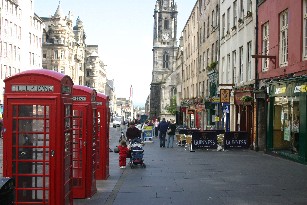 )
towards Edinburgh
Castle. The street is a big tourist draw and you cannot fail to notice that.
Countless souvenirs shops and some far fetched tourist attraction vie for
attention. Half way up we have lunch at Always Sunday
a lunchroom with nice sandwiches and salads. All organic and fair trade, so very
correct. We continue until the gates of the castle, which we - like Holyrood -
have already visited on a earlier stay. We turn off the Mile down to the National
Museum of Scotland. This purpose built museum is about ten years old and
should )
towards Edinburgh
Castle. The street is a big tourist draw and you cannot fail to notice that.
Countless souvenirs shops and some far fetched tourist attraction vie for
attention. Half way up we have lunch at Always Sunday
a lunchroom with nice sandwiches and salads. All organic and fair trade, so very
correct. We continue until the gates of the castle, which we - like Holyrood -
have already visited on a earlier stay. We turn off the Mile down to the National
Museum of Scotland. This purpose built museum is about ten years old and
should 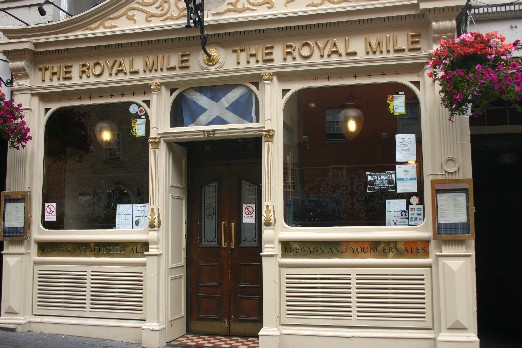 give a comprehensive overview of the development of Scotland in terms of
culture, economy, politics, technology and even sports. It is a bit of a maze,
set up thematically, rather than chronologically. The building itself is
impressive with a huge atrium and a high tower. The exhibition is nice, but you
have to find your way through it and some previous knowledge of Scottish history
is needed if you want to put the various subjects presented into the right
context.
give a comprehensive overview of the development of Scotland in terms of
culture, economy, politics, technology and even sports. It is a bit of a maze,
set up thematically, rather than chronologically. The building itself is
impressive with a huge atrium and a high tower. The exhibition is nice, but you
have to find your way through it and some previous knowledge of Scottish history
is needed if you want to put the various subjects presented into the right
context.
After the museum we go back to the B&B. At the end of
the beautiful afternoon we take the car up Calton Hill to enjoy the
views. The hill top is filled with quasi classic  objects like a unfinished "Parthenon", that was meant to serve
as a national monument, but is often called a "national disgrace".
There is also the Burns Monument, a round Corinthian temple like thing and the Nelson Monument.
At night we eat at La
Favorita, near the B&B. A prize winning popular Italian place. We go to
bed early, because have to be up early tomorrow for our flight back to the
Netherlands
objects like a unfinished "Parthenon", that was meant to serve
as a national monument, but is often called a "national disgrace".
There is also the Burns Monument, a round Corinthian temple like thing and the Nelson Monument.
At night we eat at La
Favorita, near the B&B. A prize winning popular Italian place. We go to
bed early, because have to be up early tomorrow for our flight back to the
Netherlands
weather: sunny, 18ºC/64ºF
Saturday 15 September 2007
We get up at 5.15 and have breakfast. Our hosts are still
asleep, but they have prepared a cool box with some breakfast things in it.
Toast, tea and coffee, we can make ourselves. We pack and leave ourselves out.
We drive through cold (6ºC/42ºF) Edinburgh to the airport Turnhouse. We
return the car at Hertz, tell our story about the flat tire, but do not receive
too much understanding from the desk assistant. [A few weeks later is all very
well resolved after I have sent them an e-mail]. We wait until the check-in
counter opens up for our flight. We have excess weight on our baggage, about 11
kg in all. It is expensive: £6 per kilo. We end up paying more for this budget
flight than we would have with KLM! The flight itself is fine. We are on the
front row and land 15 minutes ahead of schedule. The baggage comes first of the
belt. We want to take the first train home to Rotterdam, but a blockage on the
track forces us to a detour via Utrecht. Finally we are home around
2.15pm.
|
